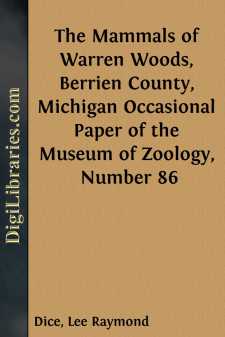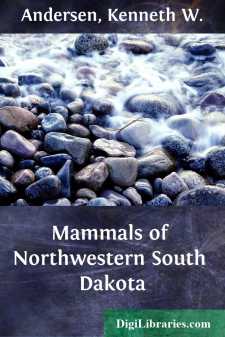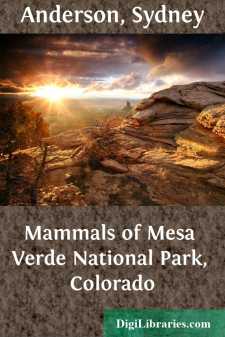Fiction
- Action & Adventure 180
- Biographical 15
- Christian 59
- Classics
- Coming of Age 5
- Contemporary Women 3
- Erotica 8
- Espionage/Intrigue 12
- Fairy Tales, Folklore & Mythology 236
- Family Life 169
- Fantasy 117
- Gay 1
- General 596
- Ghost 32
- Historical 808
- Horror 43
- Humorous 160
- Jewish 25
- Legal 4
- Medical 22
- Mystery & Detective 315
- Political 49
- Psychological 41
- Religious 64
- Romance 159
- Sagas 11
- Science Fiction 730
- Sea Stories 113
- Short Stories (single author) 537
- Sports 10
- Suspense 1
- Technological 8
- Thrillers 2
- Urban Life 31
- Visionary & Metaphysical 1
- War & Military 173
- Westerns 199
Classics Books
Sort by:
by:
Lee Raymond Dice
Few detailed studies of the mammal associations of the forests of the United States have been made. But if we are ever to know, for our different species of mammals, the natural environments under which their evolution and differentiation occurred, we must study and describe their habitats and habitat limitations before all the native areas in the country have been altered by the activities of mankind....
more...
The mammalian fauna of the western Dakotas and adjacent Montana is relatively poorly known. Few published reports have dealt with mammals from this part of the Northern Great Plains, and none of these involved detailed study of a restricted area. The present report summarizes information gathered in Harding County, northwestern South Dakota, and includes material on the more than 50 species of mammals...
more...
by:
Sydney Anderson
INTRODUCTION A person standing on the North Rim of the Mesa Verde in southwestern Colorado sees a vast green plain sloping away to the south. The plain drops 2000 feet in ten miles. On a clear evening, before the sun reaches the horizon, the rays of the sun are reflected from great sandstone cliffs forming the walls of deep canyons that appear as crooked yellow lines in the distance. Canyon after...
more...
by:
George MacDonald
"Na, na; I hae nae feelin's, I'm thankfu' to say. I never kent ony guid come o' them. They're a terrible sicht i' the gait." "Naebody ever thoucht o' layin' 't to yer chairge, mem." "'Deed, I aye had eneuch adu to du the thing I had to du, no to say the thing 'at naebody wad du but mysel'. I hae had nae leisur' for...
more...
Forming the northeastern border of Mexico, Tamaulipas extends in an elongated, north-south direction from the Temperate into the Torrid Zone and contains faunal elements from both the Nearctic and Neotropical regions. The mammals are less known than those from some of the bordering states; for the most part collecting has been limited to a few localities, chiefly along the Pan-American Highway....
more...
The University of Kansas Museum of Natural History received from J. R. Alcorn and Albert A. Alcorn a sizable collection of mammals taken in the summer of 1951 in Alaska. In addition to visiting localities at which they had collected in 1947 and 1948 (see Baker, Univ. Kansas Publ., Mus. Nat. Hist., 5:87-117, 1951) the Alcorns obtained specimens from localities not previously visited in the vicinity of...
more...
CHAPTER I The bride hammered the table desperately with her gavel. In vain! The room was in pandemonium. The lithe and curving form of the girl—for she was only twenty, although already a wife—was tense now as she stood there in her own drawing-room, stoutly battling to bring order out of chaos. Usually the creamy pallor of her cheeks was only most daintily touched with rose: at this moment the...
more...
by:
Andrew Lang
I INTRODUCTORY CHAPTER The modern Science of the History of Religion has attained conclusions which already possess an air of being firmly established. These conclusions may be briefly stated thus: Man derived the conception of 'spirit' or 'soul' from his reflections on the phenomena of sleep, dreams, death, shadow, and from the experiences of trance and hallucination. Worshipping...
more...
INTRODUCTION THE REDISCOVERY OF THE BIBLE In the early Christian centuries thousands turned to the Bible, as drowning men to a life buoy, because it offered them the only way of escape from the intolerable social and moral ills that attended the death pangs of the old heathenism. Then came the Dark Ages, with their resurgent heathenism and barbarism, when the Bible was taken from the hands of the...
more...
CHAPTER I THE ARRIVAL Toward the close of a pleasant September afternoon, in one of the years when the big stick of President Roosevelt was cudgeling the shoulders of malefactors of great wealth, the feverish home-bound masses which poured into upper Fifth Avenue with the awakening of the electric night were greeted by the strangest of all spectacles which can astound a metropolitan crowd harassed by...
more...











